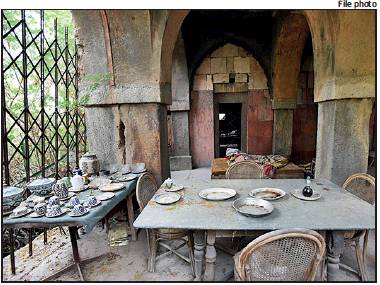Delhi: Malcha Mahal
This is a collection of articles archived for the excellence of their content. |
History, and planned renovation
Atul Mathur , Oct 3, 2019: The Times of India

From: Atul Mathur , Oct 3, 2019: The Times of India
Malcha Mahal, the 14th century Tughlaq-era hunting lodge in Central Ridge along Sardar Patel Marg, which was inhabited by the descendants of the Nawab of Awadh till a couple of years ago, is all set to be taken out of its current state of utter neglect.
The Delhi government archaeology department has decided to take over the heritage structure, which was treated as a private property by the last occupants, conserve it and open it for history aficionados. Sources said the government has asked Indian National Trust for Art and Cultural Heritage (Intach) to prepare a detailed proposal for its restoration.
Sources said Intach has already sent a basic proposal on the restoration of the structure and will prepare a detailed plan as soon as Delhi government gives its nod. Currently, the palace doesn’t figure as a protected monument in the list of both Archaeological Survey of India and Delhi’s archaeology department.
The palace was built by Feroz Shah Tughlaq, where he would spend a considerable time on his hunting excursions. It derived its name from the village Malcha where it was built.
In May 1985, the central government gave the palace to Begum Wilayat Mahal, who had been living out of the first class waiting room at New Delhi Railway Station for almost a decade. She shifted to the lodge along with her son Prince Ali Raza, daughter Sakina, a few servants and 11dogs. While she died in 1992 after swallowing diamonds, Sakina passed away a few years later.
Raza, who lived as a recluse and rarely met anyone, died a pauper in September 2017. Since then, Malcha Mahal had been lying vacant and in ruins.
If the AAP government gives its nod, the conservation work would start within a month. The restoration would take a few years to complete and would have to be done in phases, said an official. “In the first phase, consolidation and conversation work will be taken up. Though it was a huge structure, currently only the main hall and a wall-like structure is visible,” he added. Sources said the thick foliage, which has damaged the structure, will be removed and trees pruned to expose the hidden edifices. “In the first phase, the pavilions at the four corners, brackets and parapets will be repaired and broken floors fixed. Other agencies will have to be roped in to provide water supply, install signage and illuminate the structure,” said the official.
“The archaeology department may also have to carry out excavation at the site as there must be other structures in the vicinity. However, this work will be carried out in subsequent phases,” the official said.
Promoted as a ‘haunted’ walk
Anuja.Jaiswal/ City’s ‘haunted’ walks begin with Malcha Mahal/ The Times of India May 2023
Delhi Tourism is set to bring the eerie into excursions in the city beginning with the spooky Malcha Mahal in Chanakyapuri. On Saturday, a walk was organised at the 14th century structure where local residents believe the spirit of Begum Wilayat Mahal, a self-proclaimed descendant of the royal family of Awadh, still lives. It is said that the begum swallowed crushed diamonds to take her own life in 1993.
Once used as a hunting lodge, the historical structure is around 1. 5km deep in a forest from the main road. According to information available on various websites, Begum Wilayat moved into the mahal in 1985 with her children, Ali ‘Cyrus’ Raza and Sakina. The trio claimed they were direct descendants of Wajid Ali Shah, the last king of Awadh though this disputed by many.
After her alleged suicide, the begum’s children tried to embalm her body themselves. It was cremated ayear later. This delay in the final rituals made the locals believe that her spirit haunts the mahal. Raza, who claimed to be the last surviving member of the family, was found dead in the mahal on September 2, 2017.
The pathway to Malcha Mahal is surrounded by shrubs and foliage, giving it a spooky feeling, particularly at night. The one-kilometre walk leads to a narrow pathway and steps, though the old building isn’t visible from the front despite being just a few feet away. The path ends in a Tughlaq-style building with multiple arched entrances. One gets goosebumps when sounds suddenly break the silence of the empty mahal.